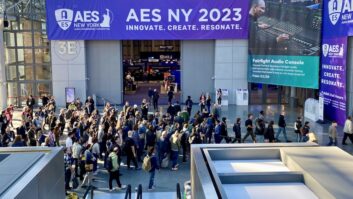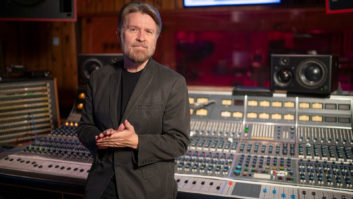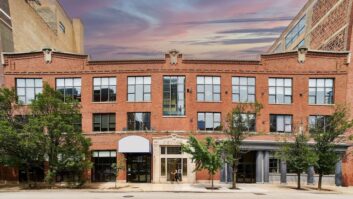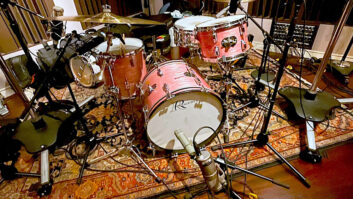Every picture tells a story, and paging through the Mix Master Directory under the New York headings provides an interesting snapshot of the New York City recording studio environment. A few of the classic names still stand out-The Hit Factory, Quad Recording, Electric Lady, for example-but they also bring to mind those that no longer appear, like Regent Sound, Mira, A&R, Automated, Skyline and Media Sound. The studio business itself is hardly a static one, and nowhere more so than in New York, where factors unrelated to the recording process nevertheless have a significant effect on the industry.
Real estate values, for example. Studio apartments can rent for $2,000 a month, if you can find one that cheap, and the city’s vertical nature has always limited the number of large tracking rooms. Even when a great location is found, all it takes is a few months of construction noise in the same area to turn an otherwise promising business into a losing proposition. In fact, it was construction of a luxury condominium skyscraper a block away in the 1980s that triggered the demise of Media Sound.
Another factor in New York’s general economic health is the stock market. Its role as a bellwether for all of the city’s business was illustrated graphically when, during last year’s Asian economic flu, brokerage Merrill Lynch issued an internal memo-henceforth, all business lunches and dinners over $200 would require the approval of a vice president-and Manhattan restaurants immediately suffered a dramatic drop in revenues. With much of the entertainment industry based around publicly funded corporations, and with the number of non-record label recordings (speculative and so-called “vanity” projects) still relatively high, the ebb and flow of capital on Wall Street is felt throughout the city.
RAP IS GOOD-BUT THERE’S MORENew York is also about diversity, and in an age and an industry (the entertainment industry, that is) that increasingly needs to pigeonhole things to get a handle on them to counter information overload, New York has been increasingly perceived as Rap City. True, New York probably does more Urban records than Atlanta and Los Angeles combined, but there’s a lot more going on in the many studios that manage to exist in the concrete jungle than meets the eye.
Even at Chung King, which built its business in the 1980s on rap before moving into a much larger five-room space in TriBeCa three years ago, studio owner John King points out that rap now accounts for about a quarter of his revenues. “The thing is, Urban music isn’t just rap,” he says. “Lauryn Hill’s record had some rap elements, as do a lot of records these days. But it’s a solid R&B/pop record. I’d say that kind of music accounts fully for half of what comes through here. Most of R&B isn’t street music; it’s pop-oriented.”
Tony Drootin, manager of audio operations at Sony Music Studios, suggests that many R&B and rap sessions tend to be last-minute bookings, often because so many producers with varying schedules work on the same project, whereas rock and pop acts tend to book far in advance and for longer stays. “That might explain the perception,” says Drootin. “But there’s plenty of rock and pop in New York.” In the last year, New York studios hosted recordings for Eric Clapton, Jon Spencer Blues Explosion, Harry Connick Jr., Savage Garden, Ricky Martin, The Black Crowes, R.E.M., Johnny Cash, Kenny Rogers, Aerosmith-I could go on, but you get the idea.
FRAGMENTATION TRENDNew York is changing in other areas. For starters, the fragmentation of recording projects is an ongoing trend. Many studios report that they are seeing fewer records done from start to finish in the same facility, and that trend is more pronounced in the major studios. “We’re seeing more pieces of projects come through here than ever before,” says Zoe Thrall, studio manager at Avatar Studios. “We’ve been constantly sending tapes back and forth across town to other facilities. I’ve got one project in here now that we’ve been the hub facility for with three other studios.”
Thrall and other studio managers believe this fragmentation phenomenon is probably caused by several factors, including the fact that substantial amounts of overdub work are done in personal studios. A less tangible yet undeniable influence is the current state of the record industry, which has been simultaneously experiencing massive consolidation, such as the Universal/PolyGram merger, and an equally massive proliferation of new independent labels, many of which are soon purchased by the larger conglomerates.
As readers of this section will recall, a business feature in April focused on the trend among record labels to postpone settling studio invoices for as long as 90 days. Some New York studios report that the situation is not getting any better, and, in some cases, it is getting much worse, sometimes as a result of billing snafus after label consolidations. Thrall notes that record labels’ A/P departments are scrutinizing invoices with a clinical eye and use even the smallest anomaly to hold up payments. “I had one entire invoice held up because of a $75 piano tuning charge,” Thrall says.
RATES CREEP UPStudio rates, while not necessarily a bright spot for most facilities, at least seem to be holding and, in some cases, creeping upward. That’s the case at Sear Sound, where studio manager Roberta Finvlay says rates have increased between 10% and 20% in the last few years, partly because the studio opened a second tracking room (which was designed by Steve Durr) late last year. “Live music recording is getting stronger in New York,” Finvlay says. “The rooms that can offer good live tracking rooms can hold the line on rates and actually improve them. And the other benefit is that we don’t have to find ourselves competing with [personal] studios. They do what they feel they need to at home, but come here for tracking and for overdubs and other things that they want the classic tube equipment for.”
With a more stable rate environment and an increased workload, some New York studio owners have made new capital investments. Sound On Sound now has a new room and a Neve Capricorn digital console. Quad Recording added an SSL M-T digital board. Electric Lady added a second SSL 9000J, and Avatar acquired its first.
But caution has hardly been thrown to the wind. King is typical of most large-facility owners. “We’re starting to watch carefully what we spend,” he says. “There’s a limit to how many new, big devices you can own. There was a period where the manufacturers of big-ticket items were [getting a lot of money for equipment]. But there’s a lot of stuff coming down the pike that costs a lot less and does just as much. I’m happy with the large consoles we have [a Euphonix CS 3000, a Neve Capricorn and two VRs, and an SSL 9000J], but that’s partly because they’re getting close to being paid off. I’m not planning on investing a lot more money in new technology. A lot of the older stuff is a lot more popular. Music is an animal art-people tend to like the simplicity of analog gear. I don’t mind spending $20,000 for the right Hammond B-3.”
But others say they would have made their recent capital upgrades regardless of the overall economy. “At the upper end of the studio business, you have to buy certain things just to remain competitive,” Thrall says. “For better or for worse, at this level of the business, that’s an expensive proposition.”
POST NEWSNew York’s post community has been buoyed by several major milestone events. Plans have been announced for a proposed $150-million production and post facility on the grounds of the old Brooklyn Navy Yard. It will be a joint venture between Miramax Films (which the Weinstein brothers started in New York over a decade ago), Robert DeNiro’s Manhattan-based TriBeCa Productions, and New York real estate developer Steven Roth. Sony Pictures has indicated it might become an anchor (no pun intended) client.
The most recent big news in the area was Todd-AO’s acquisition of Manhattan’s Sound One facility in June. Close on the heels of Todd-AO’s acquisition of Sound One, Liberty Media Group, the cable television programming unit of AT&T Corp., agreed to acquire control of Todd-AO for about $92.5 million in stock. The move, announced July 30, essentially makes Todd-AO the post-production arm of Liberty, which has extensive media (television, film and Internet) holdings in North America, Europe, Asia and Latin America. (In a separate transaction, Liberty also agreed to buy control of L.A. audio post-production company Soundelux Entertainment Group, for $70.3 million in stock.) Liberty said it plans to use the companies’ services for its existing businesses, which includes Encore Media Group and stakes in Discovery Communications Inc., QVC Inc. and Time Warner Inc.
That move seems to be part of the overall consolidation trend taking place in the entertainment industry, and is in line with consolidations on the corporate level and at the studio level, such as The Hit Factory’s acquisition of Miami’s Criteria Studios. Jeremy Koch, Sound One’s president and now also a senior vice president at Todd-AO, also noted that the key to the alliance was to position this facility as a “gateway to Europe and as a hub to our international movie activities.”
Among New York’s plethora of mid-sized, multi-room post facilities, Sound Hound is typical. The six-room facility works Madison Avenue and episodic television heavily, but when that work drops off in the summer, the studio shifts to on-air promo work for forthcoming network fall prime-time schedules, as well as corporate work. “New York is the center of more audio post than it seems,” says Gail Nord, studio manager of the 25-year-old facility. “Many agencies like New York because its talent pool is so big. I have agencies from Ireland using our ISDN lines to record local voice talent.”
Nord acknowledges that even post facilities have to cut deals on rates. The days of a spendthrift Madison Avenue are over, and cost cutting is rampant in the media industries. “But facilities like this haven’t been hurt by sound design moving into home studios,” says Nord. “The larger clients know they need the kind of technologies a place like this has to make their projects competitive.”
MID-SIZED ROOMSSome mid-level studio owners are increasingly using their facilities as a base for production and artist development ventures. Will Schillinger’s Pilot Recording is typical: it comprises one main tracking and control room, and a small second studio equipped for digital editing. Schillinger says his business is growing in the sense that the level of clientele the facility attracts has been moving steadily up-he recently hosted dates for Patti Scialfa and Eric Clapton-and his own production career has been flourishing. About 15% of revenues come from production, another 10% from Schillinger’s studio-based MP3-oriented record label.
Schillinger is considering expanding the studio and possibly adding a mix room, but like most New York studio owners he has had to cope with the realities of the real estate market. The Chelsea studio had five months of down time earlier this year while the building underwent significant renovation for a new store on the ground level. But in true New York style, Schillinger used the inconvenience as leverage with his landlord to increase the term of the studio’s lease. “If you have an outstanding live space and good gear, mid-sized rooms can make it here,” he says.
Though Schillinger’s sentiments reflect the feelings of others in the mid-level studio sector, there have been some closures, including Room With A View earlier this year, and Harold Dessau Recording in mid-year. Dessau’s owner Brian Kelly partly attributes the closure to difficulty in keeping a one-room facility booked.
On the bright side, new facilities include SG Music and Media, opened in the beginning of the year on downtown Walker Street. Co-owner Lenny Charles, a guitarist, designed the facility’s large, 80x25x16 main room for multiple purposes. He has hosted tracking sessions and marketed it to television as a shooting stage. (The Today Show has been a client.)
Acknowledging that he may be a “better guitarist than a businessman,” Charles says that number crunching is not what the studio business should be about. “I wanted a room that musicians would come into and say, ‘I want to record here,'” he states. Charles is marketing the studio towards jazz, world music and other acoustically oriented genres (a niche he feels is underserved in New York’s high-tech studio market).
Perry Margouleff, who owns the one-room, decidedly vintage-oriented Pie Studios on Long Island, has a different perspective on the mid-sized market. Margouleff observes that strength in that market sector may lie in a thin but resilient stratum: first albums by young rock bands. “It’s interesting: Studios like mine get a lot of bands making their first albums for major labels,” he says. “It could be that the labels want to keep them close by while they’re doing their first album. Then, if they make it to the second record, the bands seem to want to go to L.A. to do it. Compared to New York, L.A. is heaven for studios doing rock bands. It’s a more guitar/rock-oriented environment out there.”
The real problem in that scenario, Margouleff adds, is that the labels are particularly stingy with first efforts in terms of budgets, perhaps a consequence of the volume signings that have recently characterized the industry, particularly as the major labels acquire independent labels and their young rosters. Whatever survives the first round gets more attention and a larger budget. “Too often they’ll say don’t worry about how it sounds, we’ll hire Tom Lord-Alge to mix it, and it’ll be fine,” Margouleff says. “I just sit here and say, ‘Why didn’t you do it right the first time?’ Mid-sized studios-good ones-are an incredible resource for record labels that are trying to develop new acts. I have a lot of big-time engineers come through here and tell me they were working in a much larger studio and only using one-third of the console.”
THE INTERNET NICHEOther studios have found new avenues of expansion. Looking Glass Studios, a mid-sized facility co-owned by recording artist/composer Philip Glass, is rapidly developing a niche with Webcasts-David Bowie did one from there in April. Studio manager Amanda Reisman says that the studio’s inclusion of ISDN, DolbyFax, EDNet and T lines, as well as the technical staff’s overall familiarity with Internet technology, contribute to that sector’s growth. The only problem is figuring out what to charge for it. “They’re using the entire facility-we didn’t have a card rate for that,” Reisman says. “It was a special event, something our billing structure didn’t have planned. We had to make it up as we went along. It was more like a press conference than a recording session.”
In short, New York looks healthy. But with historical pressures from real estate and finance, combined with the rapidly changing face of the entertainment business in general, it’s a place that sleeps with one eye open. And that’s not hard, thanks to the noise.







